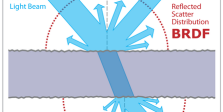
BSDF = BRDF + BTDF
BSDF – “Bidirectional scattering distribution function” is a goniophotometric measurement for the light scattering off and through the surface of a material.
BSDF can be separated into the reflected and transmitted components – BRDF (Bidirectional reflectance distribution function) and BTDF (Bidirectional transmittance distribution function). A BSDF scattering pattern can be uni-planar but often several views are assembled to present a three-dimensional scattering model of how light interacts with the material.
BRDF – “Bidirectional Reflectance Distribution Function” assumes a solid, opaque sample surface and measures the reflectance of a target as a function of illumination geometry and viewing geometry. The scattering pattern of the surface of a material is dependent on wavelength and on multiple structural and optical properties.
Remote sensing and sophisticated animation modeling are two areas of application for BSDF. Another area is in the design of sophisticated optical devices that have been modeled with ray tracing software and a prototype built. At this point, a BSDF measurement might be performance of the prototype device to see how well the optical properties of the prototype match the tracing model.
While colorimetry is often determined from the BSDF reflectance or transmission data, BSDF light scattering patterns are not typically measured for most typical industrial products while color often is.

